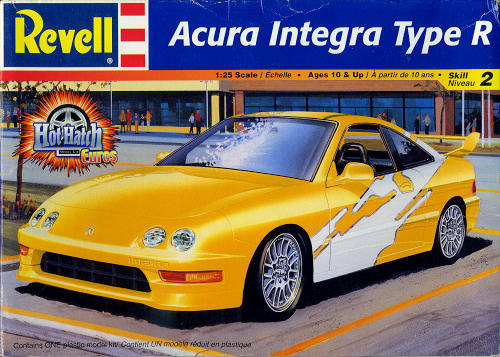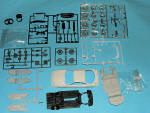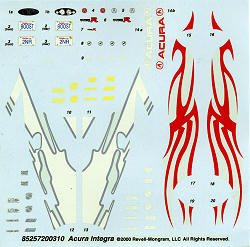
Revell 1/25 Acura Integra Type R
| KIT #: | 2572 |
| PRICE: | Bought already started for $5.00 |
| DECALS: | Three options |
| REVIEWER: | Scott Van Aken |
| NOTES: | Includes complete engine, interior and detailed chassis |

| HISTORY |
The Honda Integra (sold in some markets as Acura Integra) is a compact sport coupe made by Honda during the years 1985 to 2007. It is usually a two door front wheel drive car that is able to house four passengers with a four door variant available.
In 1998, the USDM Integra underwent a mid-generation facelift. The changes included new front and rear bumpers with slightly modified headlights, red rear turn signals, and the deletion of the RS trim. The steering wheel now featured the Acura emblem rather than the word "Acura," and the sticker under the hot/cold lever on the climate control was changed slightly.
Beginning in 1998 with the deletion of the RS trim level, all Integras came equipped with alloy wheels. The LS trim was equipped with 14 inch alloy wheels, but could be upgraded to the more common 15 inch wheels. 1998 was also the first year in which the GS-R was equipped with wheels unavailable on any other trim level. USDM Integras from 1994-2001 also had the option of dealer installed optional alloy wheels.
The Type R was the pinnacle of the Integra line. It had many exclusive features not found on any other Integra. This trim of the Integra only came with a 5 speed manual transmission. The interior had red stitching on the arm rest and shift knob for 1998, and after year 2000, faux carbon fiber for cup holders, climate control, cluster bezel, and the shifter plate. The Canadian market received a limited number of vehicles in the final year of production (2001) with the ultra rare red interior which composed of red front and rear seats.
The Type R's B18C6 (EDM/UKDM), B18C5 (USDM) engine was not merely a tuned version of the GS-R's B18C1. The Type-R's head is a re-worked PR-3 head, with better valves, camshafts, retainers, stiffer valve springs and a red cover. During production, the B16 heads would get a green marker line to signify a 'perfect cast', and these would be the heads put away and later used for Type R engines which would receive a hand port and polish. Molybdenum-coated, high compression pistons and stronger-but-lighter connecting rods strengthened the reciprocating assembly. Extra counter-weights were installed on the crankshaft which altered its vibration modes to enhance durability at high rpm. The intake valves were reshaped with a thinner stem and crown that reduced weight and improved flow. The intake ports were given a minor port and polish. Stiffer valve springs resisted float on more aggressive camshafts. Intake air was now drawn from inside the fender well, for a colder, denser charge. That intake fed a short-runner intake manifold with a larger throttle body for better breathing. An improved stainless steel exhaust collector with more gentle merge angles, a change to a larger, consistent piping diameter, flared internal piping in the muffler allowed easier exit of gases. A re-tuned engine computer also contributed to improved power output, which allowed the Type-R to accelerate from 0 to 60 mph (100 km/h) in 6.2 seconds (as opposed to the GS-R's 7.0).
The transmission gearing used was very similar to that of the Civic Si from 1999–2000, which featured closer gear ratios in second through fifth gears, in order to take advantage of the additional rev range. However, the Type R transmissions featured stronger synchros in all 5 gears. The North American version retained the same 4.4 final drive throughout the Type-R's production run, unlike the Japanese version, which in 1998 changed to a 4.785 final drive along with revised gearing (However the 4th and 5th gear in the 4.785 transmission was from the GSR transmission, which made the ratios for 4th and 5th on the 4.75 nearly identical to the 4th and 5th gear in the 4.4 tranny, resulting in easier cruising at higher speeds). Unlike the other model Integras with a open differential, the Type R came with a torque-sensing limited slip type.
The chassis received enhancements in the form of reinforcements to the rear wheel wells, roof rail, and other key areas. "Performance rods", chassis braces that were bolted in place, were added to the rear trunk wall and sub-frame. The front strut tower bar was replaced with a stronger aluminum piece. Honda marketed a rear strut tower bar as a dealer accessory as well, but it required cutting of the damper mount access panels. Camber rigidity was improved at the rear by increasing wheel bearing span by 10 mm. This rigidity was further improved in 1998 when the smaller upper suspension link was changed from a stamped steel part to a fabricated part with a more rigid bushing. The Type-R's body also received a new functional rear spoiler, body-colored rocker panels and front lip, and 5-bolt hubs with special lightweight Type-R wheels. Under those wheels was a much larger set of disc brakes, front and back. The tires were upgraded to Bridgestone RE010 summer tires.
The Type-R received very aggressive tuning in its suspension settings. All soft rubber bushings were replaced with much stiffer versions, as much as 5.3 times higher in durometer readings. The springs and dampers were much stiffer, with a 10 mm (0.4 in) reduction in ride height. The rear anti-roll bar diameter was initially increased to 22 mm (0.9 in) in diameter, and further enlarged to 23 mm in diameter in 1998. The front anti-roll bar retained the same size, although the end links were changed to a more responsive sealed ball joint as opposed to a rubber bushing on the lesser models. The result was a chassis with very responsive, racetrack-ready handling that ably absorbed mid-corner bumps. Mild oversteer was easy to induce with a lift of the throttle, and during steady-state cornering the car maintained a slight tail-out stance.
The interior was stripped down to reduce weight. The air conditioning system was optional in early models and nearly all the sound-dampening material was eliminated. This provided for a much noisier ride, but since the Type-R was marketed as a race car for the street, most owners didn't mind. The seats were also unique to the Type-R. For the U.S. market, the upholstery was done in Alcantara and mesh, with the bottom cushion made softer than the standard Integras to preserve comfort. The Japanese market cars used Recaro SRII seats—a slightly smaller variant of the Recaro SRD. This seat is actually heavier than the standard Integra seats.
| THE KIT |
 Odd to find a Japanese car in a boxing that touts
"Hot-Hatch Euros", so perhaps they were referring to the currency or something.
As a US designed kit, it is 1/25 scale, whereas a Revell Germany mold would have
been 1/24th. This 2000 kit was produced while Revell was still owned by Hallmark
cards, so perhaps that is why we find this one so marketed.
Odd to find a Japanese car in a boxing that touts
"Hot-Hatch Euros", so perhaps they were referring to the currency or something.
As a US designed kit, it is 1/25 scale, whereas a Revell Germany mold would have
been 1/24th. This 2000 kit was produced while Revell was still owned by Hallmark
cards, so perhaps that is why we find this one so marketed.
My kit was already started with the previous owner
gluing on several of the body parts. Hence the cheap price. However, all the
parts are present in the box (at least as far as I can tell). Typical of Revell
kits, the molding is superb. It is one reason I generally prefer Revell-Monogram
over AMT/ERTL kits, which seem to have softer molding (not to mention inferior
fit). 
The kit has a full interior, a complete engine and a nicely done chassis plate onto which one will eventually attach the suspension. The kit also includes metal axle stub pins as well as a metal exhaust tube. All of the custom bits are limited to a selection of wheels (two chrome and a standard plastic), as well as lower fore and aft body valence sections and rear wing. The previous owner had installed the custom bits on the body.
Instructions are well done, as one expects from Revell. Color information is provided throughout the superbly drawn construction sequences. Apparently this car is supposed to be painted yellow as is on the box art. Decals are starting to show their ten year old age and consist of dash instruments, license plates and large side art work. The decals are well done and a bit on the thick side. I've used very old Revell decals in the past and they have often proven to still be quite viable.
| CONCLUSIONS |
If you like rice rockets, then this is one you really should seek out. I'm sure it won't be that difficult to locate from vendors at shows or from evil-bay and should make into a very nice model.
| REFERENCES |
http://en.wikipedia.org/wiki/Acura_Integra
December 2010
Thanks to me and my tendency towards frugality for this one If you would like your product reviewed fairly and quickly, please
contact
me or see other details in the
Note to
Contributors.